Just how poppin’ is this year’s California poppy bloom?
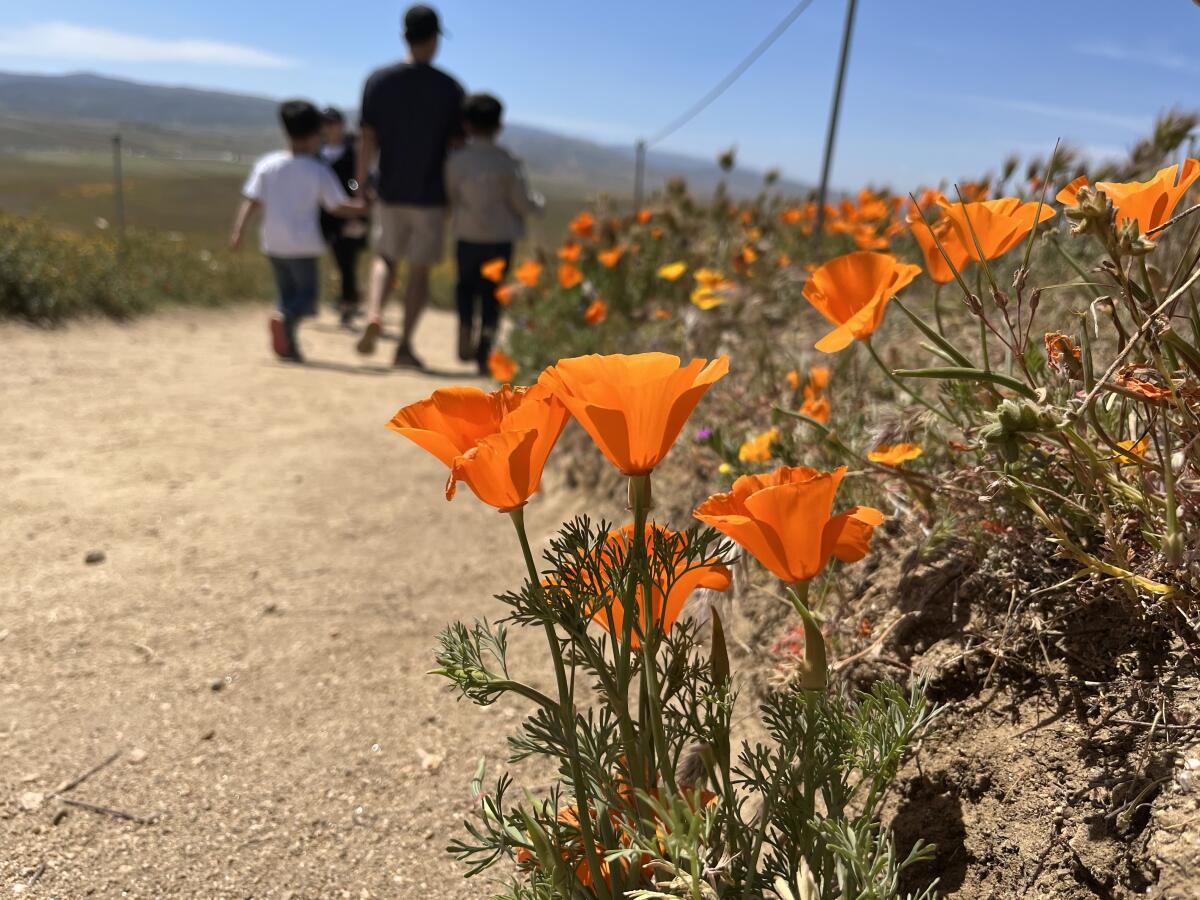
Good morning, and welcome to the Essential California newsletter. It’s Tuesday, April 18.
Large numbers of a little orange flower are drawing thousands out to the far north of Los Angeles County. But just how bright is this year’s bloom?
While a bountiful rainy season raised hopes of a superbloom, the orange-hued hillsides at the Antelope Valley California Poppy Reserve aren’t fully popping this spring.
Despite that, poppy seekers are driving out to the desert each week to get a glimpse — and plenty of photos — of California’s iconic wildflower. On Sunday, the road leading to the reserve was slow going for miles. The parking area up at the reserve was full for a time, leaving visitors to park where they could and walk up to the trailheads.
Once you get on the trails, you’re sure to see the trademark orange of Eschscholzia californica, which became the state flower 120 years ago.
But you’ll also see a lot of yellow flowers on curled stems towering over the poppies. These are fiddlenecks, and as state park volunteer Patrick Saatzer explained, cold conditions in recent weeks gave these and other plants an advantage to “overwhelmed the poppies.”
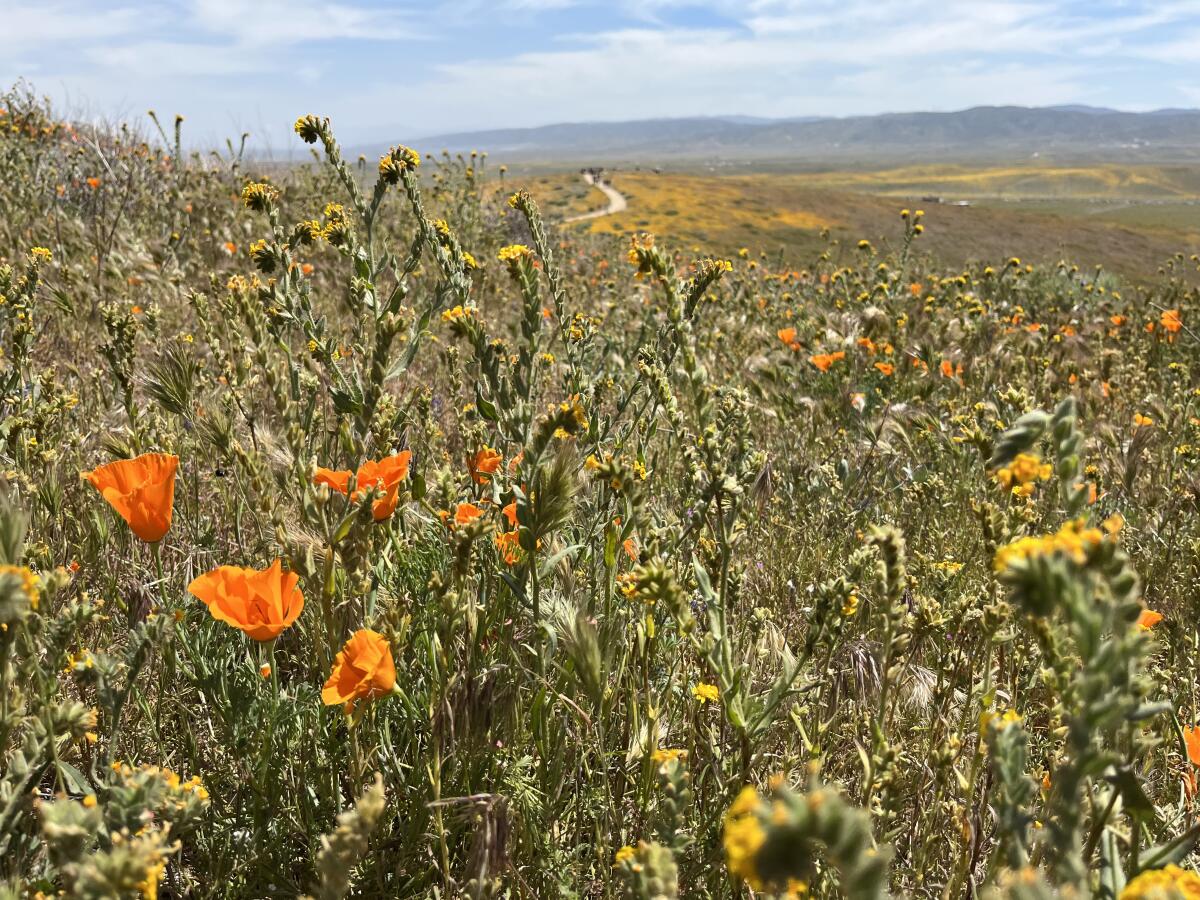
Saatzer, a retired Air Force colonel, has been a volunteer at the state park for three years and gives this year’s bloom a “C” compared to the past couple years.
Despite some visitors seeming “a little bit underwhelmed,” Saatzer said he enjoys meeting “all the different people that come out here [from] a lot of different countries.”
“They’re all really fascinated with the wildflowers,” he said.
But he wishes the state would step up their efforts to deal with the resulting traffic.
“What they need to do out here is have a shuttle bus because look at this,” he said, gesturing to the long line of cars stretching nearly a mile from the road adjacent to the reserve, along the street at the front entrance and up to the parking lots. “It’s just a disaster.”
After finding a spot in the lot — or making the long walk up from the main road below — families, couples and friends wandered the winding trails, taking in the view and snapping plenty of photos along the way.
Summer Kim made the drive from Anaheim with family and friends, hoping to see the bloom.
“I heard it is not that much of a superbloom because it has been so cold,” she said. Still, they enjoyed a rare “outdoorsy” adventure.
As far as what constitutes a superbloom, that’s really in the eye of the flower beholders.
“The superbloom is really a cultural phenomenon, where people decide that there are enough flowers here, right now, that we’ll call it a superbloom,” Daniel Winkler, a research ecologist with the U.S. Geological Survey, Southwest Biological Science Center, recently told The Times.
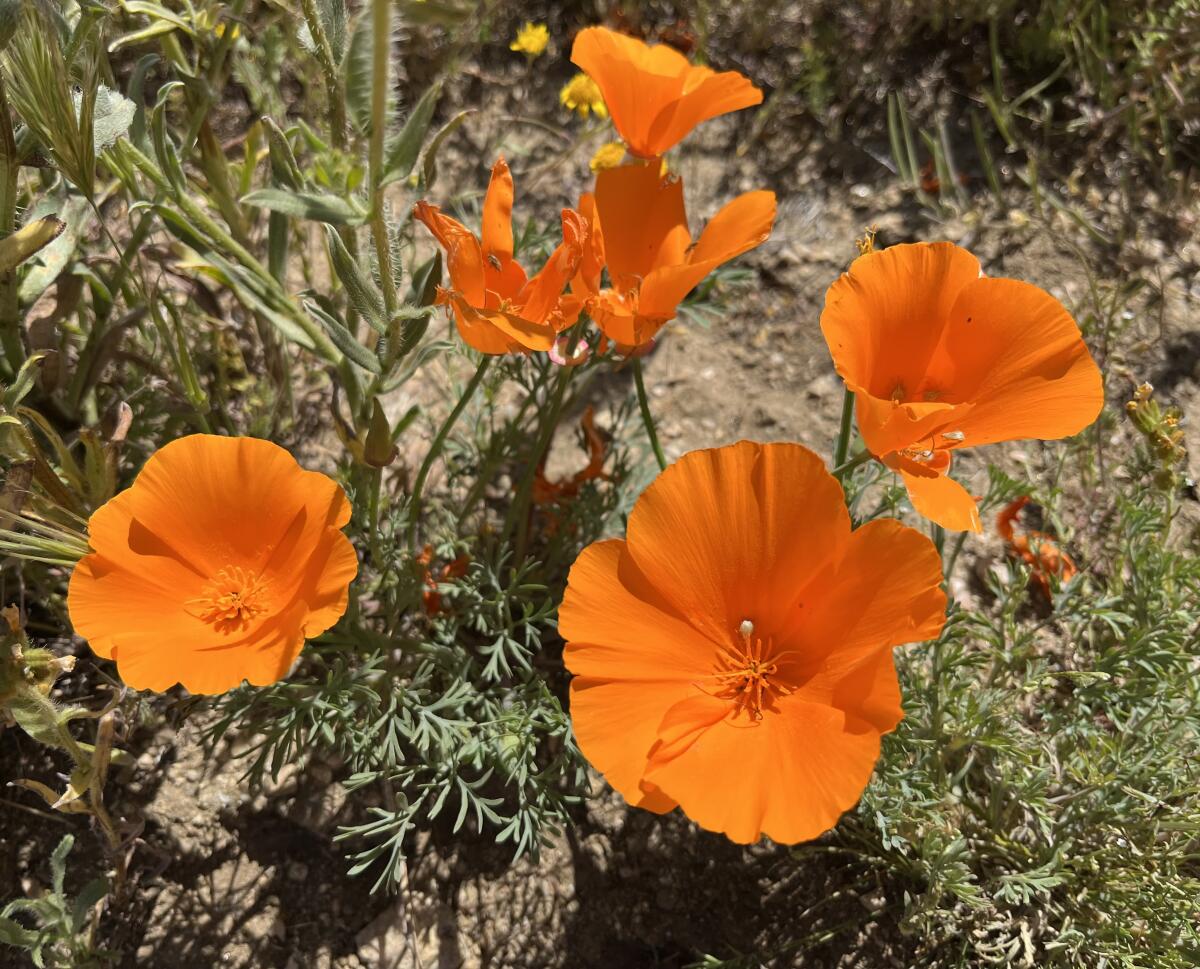
From a hilltop with a 360-degree view of the reserve and the surrounding Antelope Valley, Melanie Copas and her daughter, Addison Copas, took some photos. The two decided to drive out from Thousands Oaks on a whim earlier that day.
“Traffic was a bear,” Melanie said. “Had we known about the traffic issue, we would have come during the week. But it’s still beautiful — worth the drive for sure.”
Their impromptu trip left 16-year-old Addison unprepared for the sunny hike, but after buying a new hat from the reserve gift shop and borrowing sun screen from a generous stranger in the parking lot, they hit the trails.
“I love the fact that I’ve heard every language today from around the world,” Melanie said.
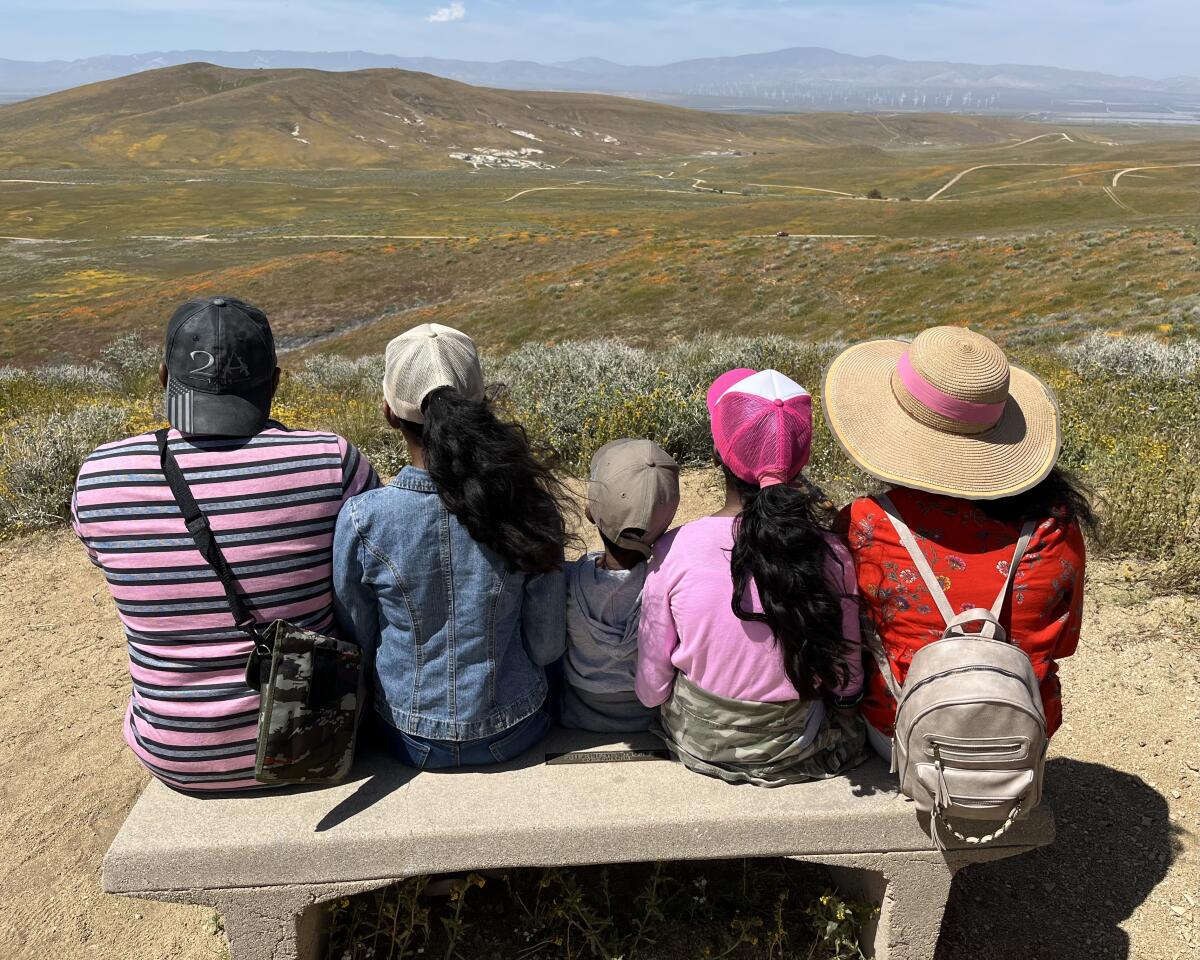
Tehachapi residents Romesh and Cynthia Abraham visited the reserve with their three kids for the first time.
“I’m just amazed to see all the greenery and the flowers blooming,” Romesh said. “The last couple years with the drought, it just hasn’t been the same.”
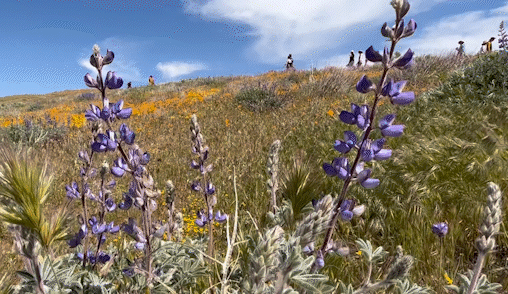
The hillsides aren’t the only place to find pops of color. Wherever people are parked to check out the poppies along local roads, there are also the rainbow umbrellas of the fruteros, selling cups of fresh fruit, raspados and more to hungry hikers.
While the poppies on the state reserve bloom (or don’t) based entirely on nature, flower seekers looking for a more uniformly orange — albeit manufactured — backdrop can find it a few miles east of the state park.
Out here, near massive electrical towers, a lush expanse of poppies stretch along a hillside in neatly formed rows.
It’s unclear who planted them, but the flowers appeared to be arranged and maintained with human help. Hundred of visitors walked along the rows and ventured into the flower fields on small paths, angling for a good photo.
Alex Khou and Sara Angione drove out from Thousand Oaks to enjoy the poppies after hearing about the supposed superbloom on the news. They snapped some photos for Instagram, but also to share with Angione’s parents back in Canada.
“It’s gorgeous... it takes your breath away,” she said. “I feel like the photos don’t do it justice.”
But photos will have to do: California law states that no one “willfully or negligently cut, destroy, mutilate, or remove plant material” of any kind growing in state or county rights-of-way, or public land or private land (without express content from the owner). That means picking poppies is illegal.
While most people walking among the poppies were watching their step and leaving the flowers alone, there were some casualties of all that foot traffic. And a few people held bundles of the orange flowers in their hand.
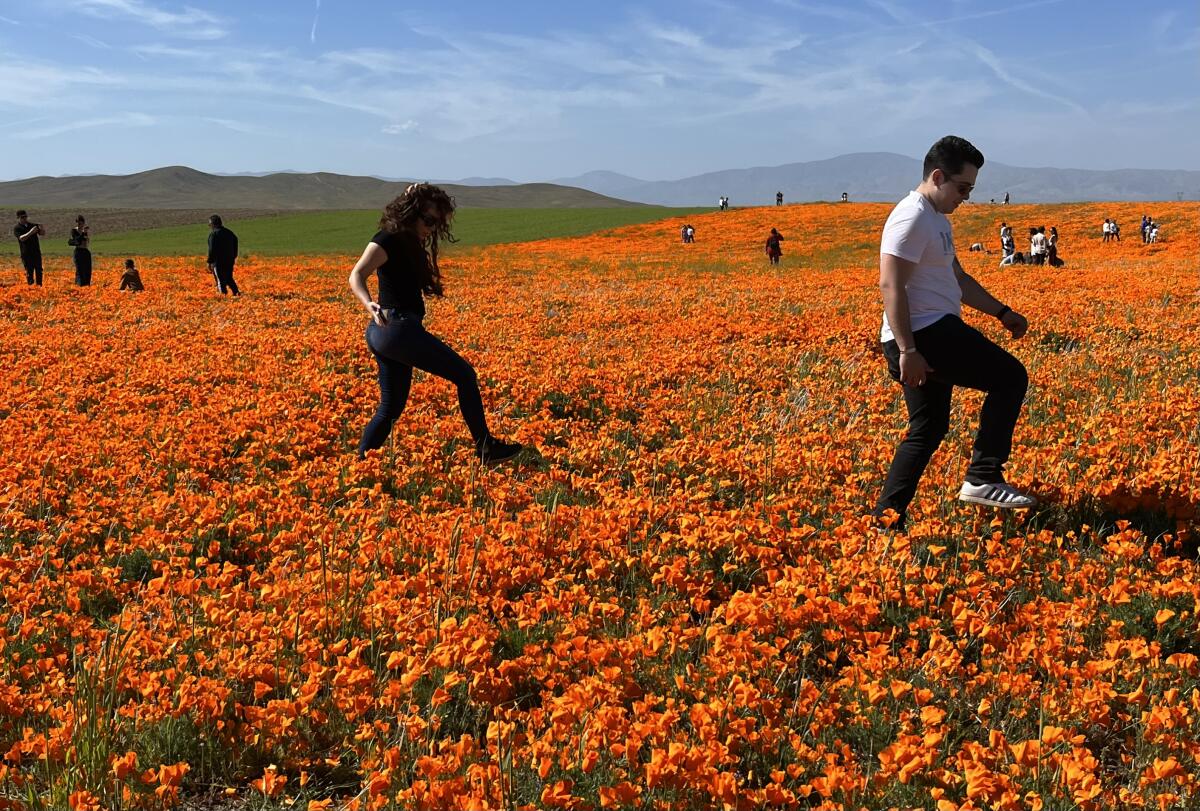
Interested in seeing the poppy bloom for yourself? Now’s the time. Next weekend marks the California Poppy Festival, which is held in nearby Lancaster and is likely draw even more people out to the reserve and blooms along the route.
Want to try elsewhere? Check our our guide: California’s breathtaking superbloom is here. Mapping where to go, see amazing photos.
Make sure to bring comfortable walking shoes, snacks that won’t melt in the desert sun, plenty of water and some patience for traffic and crowded trails. And after waiting in line to park, be prepared to wait in line for the bathrooms as well.
And now, here’s what’s happening across California:
Note: Some of the sites we link to may limit the number of stories you can access without subscribing.
Check out "The Times" podcast for essential news and more
These days, waking up to current events can be, well, daunting. If you’re seeking a more balanced news diet, “The Times” podcast is for you. Gustavo Arellano, along with a diverse set of reporters from the award-winning L.A. Times newsroom, delivers the most interesting stories from the Los Angeles Times every Monday, Wednesday and Friday. Listen and subscribe wherever you get your podcasts.
POLITICS AND GOVERNMENT
Happy Tax Day! Actually, for many Californians, it’s not. The state and federal deadline was pushed to October for residents in dozens of counties affected by the winter’s severe storms. If you’re wondering how that affects you, here are some more burning tax questions answered. San Francisco Chronicle
The city of Berkeley’s first-in-the-nation ban on natural gas lines in new buildings was blocked by a federal appeals court Monday. The California Restaurant Association challenged the city’s measure, contending that federal laws regulating the efficiency of some gas-powered appliances don’t allow the city to effectively ban those same appliances. The ruling could hamper similar ban efforts across the state. Los Angeles Times
CRIME, COURTS AND POLICING
Two Torrance police officers will face manslaughter charges for the 2018 fatal shooting of Christopher Deandre Mitchell. L.A. County Dist. Atty. George Gascón decided to reopen the case against Matthew Concannon and Anthony Chavez following his predecessor’s declination to prosecute in 2019. Both officers pleaded not guilty Monday. Los Angeles Times
Authorities in Northern California have arrested 17 people in connection with 11 gang-related Sikh shootings. The violence between the rival groups began in 2018 with fist fights and sword attacks and later escalated to shootings in communities across several California counties. Los Angeles Times
Support our journalism
HEALTH AND THE ENVIRONMENT
California’s heavy rains and resulting floods wreaked havoc on dairy farmers in the San Joaquin Valley. Now, as the Sierra Nevadas’ record snowpack begins to melt, many are worried more flooding is on the horizon. CalMatters
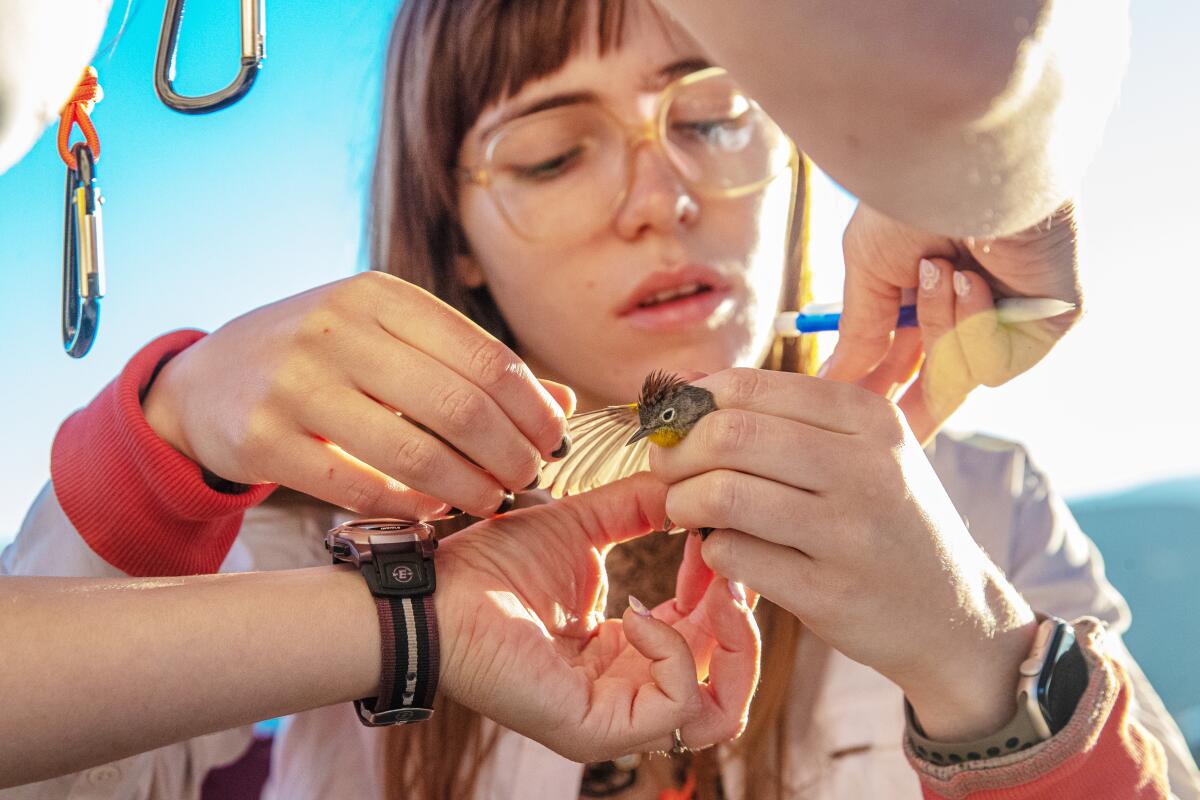
A dirt parking lot in the San Gabriel Mountains has become a magnet for migrating birds. Scientists aren’t entirely sure why thousands of birds are passing through the area each day, but it’s become a hotspot for research. Los Angeles Times
CALIFORNIA CULTURE
In a nearly unanimous vote, members of the Writers Guild of America authorized a strike as their contract deadline nears. The current three-year film and TV contract expires May 1. The union is seeking increased pay and residual payments, fueled by streaming platform’s upheaval of the industry. Los Angeles Times
Free online games
Get our free daily crossword puzzle, sudoku, word search and arcade games in our new game center at latimes.com/games.
AND FINALLY
Today’s California landmark is from James Hartmann of Altamonte Springs, Fla.: Fort Ross State Historic Park in Sonoma County.
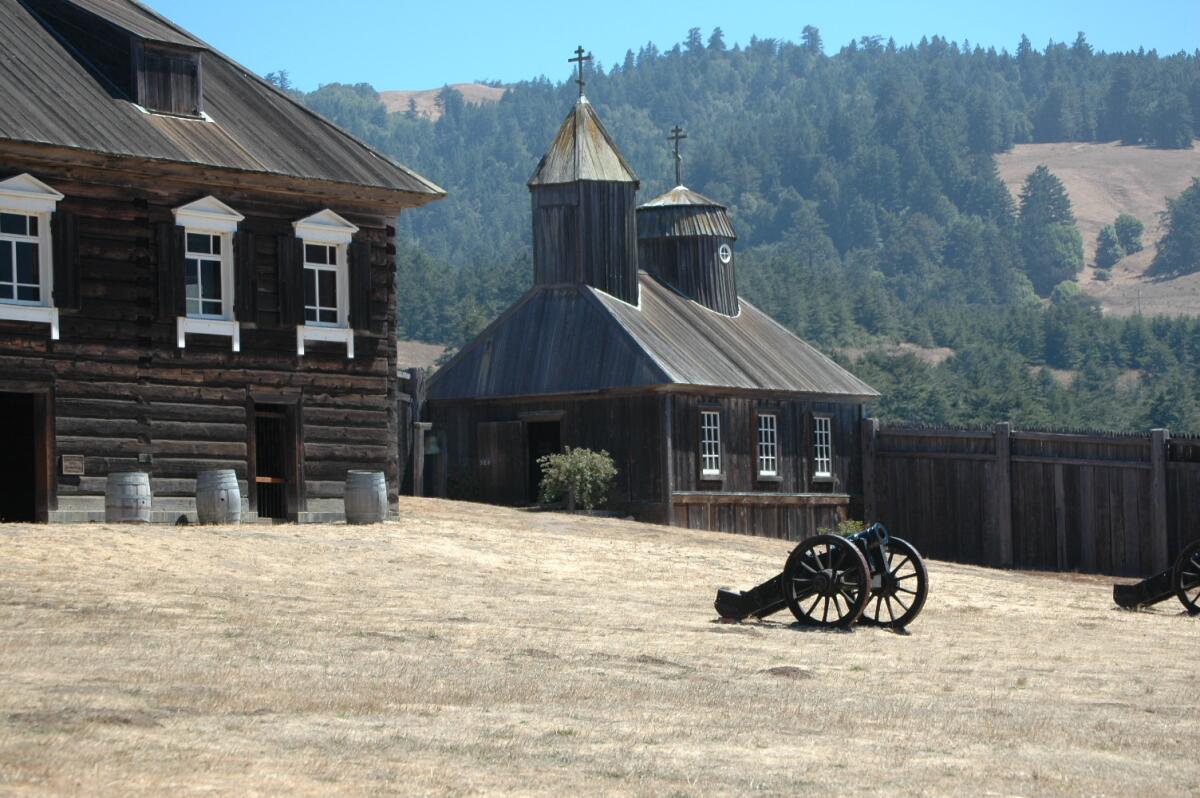
James writes:
Fort Ross, part of a Russian settlement from 1812 to 1841, sits in a beautifully restored and maintained condition just north of Jenner on the Sonoma coast. Now part of the California State Parks system, it’s a wonderful stop on Highway 1. A museum like none other.
What are California’s essential landmarks? Fill out this form to send us your photos of a special spot in California — natural or human-made. Tell us why it’s interesting and what makes it a symbol of life in the Golden State. Please be sure to include only photos taken directly by you. Your submission could be featured in a future edition of the newsletter.
Please let us know what we can do to make this newsletter more useful to you. Send comments to [email protected].
Sign up for Essential California
The most important California stories and recommendations in your inbox every morning.
You may occasionally receive promotional content from the Los Angeles Times.




